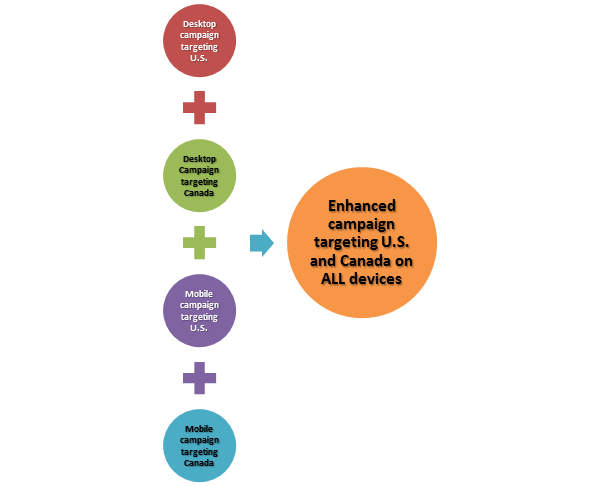Why the Change?
The advancement of internet usability on mobile devices, combined with more people getting their hands on them, has led to rapid growth of mobile search usage. When you factor in technology like AdWords, you can see how advertisers have more opportunity to deliver—and consumers to receive—targeted advertising messages that are relevant for more specific devices, times and locations than ever before.
Yet, not many advertisers were creating AdWords campaigns for mobile devices, simply because the campaign structure was difficult to discern and hard to manage. This, of course, was costing Google money in ad clicks and costing advertisers conversions from prospects searching for what they offer. So Google came up with “Enhanced Campaigns” as a solution.
The idea was to create a new campaign structure that would cluster targeting for all of these variables into one campaign. This way, advertisers would enter the mobile space by default, instead of needing to have the knowledge and time to create and manage separate campaigns for each device, time and location. Now when you create a campaign, you can customize them around all of these variables so you can show the right ad, on the right device, at the right time, in the right location.
How They Work
Set Up
The main difference between Enhanced Campaigns and the old ones is that instead of having to break campaigns out for bidding on all of the variants in your account (device, location, time), you can now specify bid adjustments for all of them within your single campaign. [tweet] For example, instead of choosing the devices you’d like to target in your campaign settings, you are targeting ALL devices in one campaign, and specifying your ads and bids for each device separately within that one campaign. Also, if you choose multiple locations to target, you can set bid adjustments up and down based upon the performance of each location.
Devices
Desktops and tablets are now considered equivalent (there are a few exceptions).
Ads
You specify what ads (with what features) you want to show at specific times on specific devices. If a searcher is near your store during your business hours searching on their mobile phone, you may want to show them a different customized ad than if they are at home during non-business hours searching on their desktop computer. Now when you create ads, you have the ability to customize your ads to these situations by telling the AdWords system which ad you want it to serve in each situation.
There is a device-preference button for ads you create that allows you to choose “mobile” if the ad is optimized for mobile devices. All others will be assumed to apply to ALL devices. If the search is on a mobile device (or in a mobile context), AdWords is saying it will show your mobile-preferred ad over others in your ad group.
NOTE: Google does keep a little flexibility here since devices can be used in many different contexts. For example, if the user is mobile, they should see a mobile ad regardless of what device they’re on. Or, if they’re on a mobile device at home, it’s more appropriate to not show an ad that carries mobile intent. Google has some ability to auto-detect the ads that are appropriate and may adjust ad serving based on this.
Bidding
Not only can you customize the ad you want to show to user context, you can customize the bid as well. You do this by setting a mobile bid adjustment to be a percentage of your default bids. This can be from -100% to +300% of default bids. Obviously, setting a bid of -100% will prevent your ads from being shown on mobile devices if you have a good reason to do so (like if your site isn’t optimized for mobile).
When you create your campaign, Google will provide a suggested bid adjustment for mobile. Since the bid adjustments only apply to mobile devices, you can see that there is now no longer such thing as a mobile-only campaign. You can’t set bids for mobile and adjust desktop bids down or up.
Conversions
There is a new conversion type in Enhanced Campaigns. It is a call duration specified by you. You can determine the minimum duration of a call from your ad that would classify the call as a conversion. This helps give you greater insight into the true value of your advertising, allowing you to adjust your targeting and bidding accordingly.
What You Should Do
With Enhanced Campaigns, setting up, managing and optimizing AdWords campaigns HAS been made EASIER. You only have to create one campaign instead of two. But, it takes more effort to do them right.
For the “layman” advertiser that isn’t dedicated full-time to building and optimizing campaigns, taking advantage of all of the new capabilities in ways that maximize campaign effectiveness—and giving them true advantages over their competitors—has become harder, simply because of all the segmentation. While this segmentation is a good thing, it requires more time and energy to use correctly. It’s not like it wasn’t the case before, but more than ever you should be taking AdWords campaigns more seriously. [tweet] If you don’t, competitors that do will pull ahead of you in this space.

